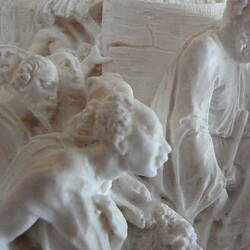Summary
Finely moulded cast plaster nativity scene, set behind convex glass, within a frame of imitation walnut, of probable European origins, possibly German or Austrian, circa 1880.
This intricately cast and carved plaster panel in high relief, depicts the birth of Christ, is an excellent example of the craftsmanship involved in this medium. The rich, deep folds of the figures' drapery and the skillful illusion of depth created in the scene clearly illustrate the artist's talents.
Framed in wood with convex glass, such religious panels would have been sold as decorative wall hangings. Similar examples of this particular plaster scene are known, suggesting that it was produced as a cast from an original, hard-carved mould.
Physical Description
Oval, relief moulded panel of the nativity. Surrounded by gold border and painted gesso frame (to look like wood grain). Paper affixed to back. No obvious markings.
More Information
-
Collection Names
-
Collecting Areas
-
Acquisition Information
Cultural Gifts Donation from Dr Will Twycross, 23 Jan 2009
-
Acknowledgement
Donated through the Australian Government's Cultural Gifts Program
-
Place & Date Made
-
Place & Date Exhibited
Royal Exhibition Building (REB), Nicholson Street, Carlton, Greater Melbourne, Victoria, Australia, 1880-1881
-
Collector
Mr John Twycross, Elsternwick, Greater Melbourne, Victoria, Australia, 1881
-
Classification
Royal exhibition building, International exhibitions, Exhibition heritage
-
Category
-
Discipline
-
Type of item
-
Overall Dimensions
465 mm (Width), 65 mm (Depth), 368 mm (Height)
-
Maximum dimensions
463 mm (Length), 50 mm (Width), 367 mm (Height)
Measurement From Conservation.
-
Keywords
Exhibitions: Melbourne International, 1880-1881, Plaster of Paris, Religious Artifacts, Royal Exhibition Building




